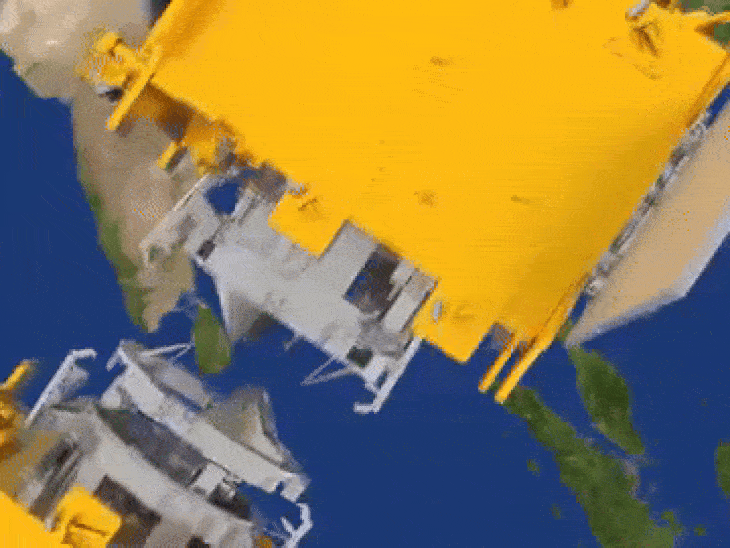The Indian Space Research Organization i.e. ISRO is all set to launch the SpaceX mission. In this mission, two spaceships traveling through space ten times faster than the speed of a bullet will be combined. This is called docking.
If the mission succeeds, India will become the fourth country to do so after Russia, America and China. India’s Chandrayaan-4 mission depends on the success of this mission, during which samples of lunar soil will be brought to Earth.
The SpaceX cost-effective technology demonstration mission will launch on December 30 from Sriharikota at 10 p.m. on a PSLV-C60 rocket. It will be broadcast live on ISRO YouTube channel from 9:30 p.m.
Spacex will launch from Sriharikota at 9:58 p.m. on a PSLV-C60 rocket.
Spacex Mission Objective: Introduce docking and undocking technology to the world
Demonstrate the technology of docking and undocking two small spacecraft in low Earth orbit. Demonstrate the technology of transferring electrical energy between two docked spacecraft. Space docking means joining or connecting two spacecraft in space.
Spacex mission process: launch from PSLV rocket, then docking 470 km above
The mission includes two small spacecraft, Target and Chaser. These will be launched into separate orbits at an altitude of 470 km from the PSLV-C60 rocket.
After deployment, the speed of the spacecraft will be approximately 28,800 kilometers per hour. This speed is 36 times that of a commercial airplane and 10 times that of a bullet.
Target and fighter spacecraft will now begin the long-range rendezvous phase. In this phase, there will be no direct communication link between the two spacecraft. These will be guided from the ground.
The spaceship will get closer. Will use a laser rangefinder to measure distances between 5km and 0.25km. The home camera will be used for a range of 300 meters to 1 meter. The visual camera will be used at a distance of 1 meter to 0 meters.
After successful docking, the transfer of electrical energy between the two spacecraft will be demonstrated. Then the spacecraft will undock and both will begin operating their respective payloads. This will continue to provide valuable data for approximately two years.
The spacecraft will be docked at an altitude of 470 km above Earth. ISRO shared an animated video of the docking.
Camera in spacecraft A and two payloads in spacecraft B.
For the autonomous mission phase after the docking experiments, Spacecraft A carries the High Resolution Camera (HRC). Spacecraft B carries two payloads: the Miniature Multispectral (MMX) payload and the Radiation Monitor (RadMon). These payloads will provide high-resolution imagery, natural resource monitoring, vegetation studies, and measurements of the on-orbit radiological environment that will have numerous applications.
Why the mission is necessary: The success of missions like Chandrayaan-4 depends on it
The technology will be used in the Chandrayaan-4 mission during which samples from the Moon will be brought back to Earth. Docking technology will also be needed to build a space station and then travel there for satellite servicing, interplanetary missions, and sending humans to Earth. Moon. This technology is necessary.
India has filed a patent for its docking mechanism
This docking mechanism was named “Indian Docking System”. ISRO has also filed a patent on this docking system. India had to develop its own docking mechanism as no space agency has shared the details of this extremely complex process.
24 payloads are also sent to the mission for experimentation.
24 payloads are also sent on this mission for microgravity experiments. These payloads will be carried in the fourth stage of the PSLV rocket called POEM (PSLV Orbital Experimental Module). 14 payloads are from ISRO and 10 payloads are from Non-Governmental Organizations (NGE).
America first docked on March 16, 1966
The first docking of two spacecraft in space took place on March 16, 1966, as part of the Gemini VIII mission. The Gemini VIII spacecraft docked with the Agena target vehicle, which had been launched earlier the same day. The Soviet Union, now Russia, first docked two spacecraft in space on October 30, 1967. The unmanned Kosmos 186 and 188 were then automatically docked. This docking was an important step in the Soviet Union’s return to flight program. China’s first space docking took place on November 2, 2011, when the uncrewed Shenzhou 8 spacecraft successfully docked with the Tiangong-1 space laboratory module. Docking took place at the Jiuquan Satellite Launch Center in Gansu, China.

